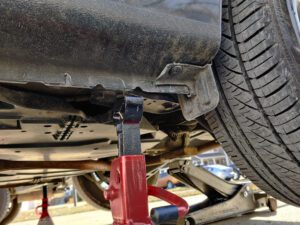Definition of Pinchweld
A pinchweld is a spot‑welding technique that sandwiches two metal plates between electrodes under high pressure, creating a weld at the contact points. It’s widely used in automotive and aerospace industries for enhanced structural strength and water resistance.
Three Common Pinchweld Shapes
| Shape | Description | Typical Use |
| Flat | Joins long horizontal metal pieces, covering chassis or frames. | Chassis covering |
| L‑Shaped | One plate vertical, one horizontal, forming an “L” joint. | Car door frames |
| Z‑Shaped | Two L‑shapes joined diagonally for maximum rigidity. | Windshield frames |
Key Applications
1. Automotive Assembly
- Secures the outer body to the inner frame, improving rigidity and sealing.
- Common at doors, chassis rails, and A‑pillar areas.
2. Jack Support Points
- Pinchwelds are often marked to indicate safe jack placement.
- Use a jack pad (wood or rubber) to distribute load and protect the weld.
3. Sealing Strip Installation
- Works seamlessly with OKIN rubber sealing strips to boost air‑ and water‑tightness, noise isolation, and corrosion resistance.

Pros & Cons of Pinchweld
Advantages
- Lower cost and faster than bolts or nuts for clamping frame components.
- Suitable for temporary or permanent metal‑to‑metal fastening.
- Provides reliable jack support points for maintenance.
- Minor weld damage can be repaired by re‑welding.
- Pairs effectively with high‑performance rubber seals for superior sealing.
Disadvantages
- Difficult to perform at complex angles or in tight spaces.
- Best suited for low‑carbon steel; not ideal for all metals.
- Poor welds can lead to frame cracks or leaks, affecting performance.
Common Issues & Solutions
| Issue | Cause | Solution |
| Corrosion | Exposed welds, damaged coating | Remove rust, re‑weld, apply primer and paint for corrosion protection. |
| Dents/Scratches | Welding pressure or external impact | Realign plates, grind smooth, re‑weld if needed, then repaint. |
| Separation | Overload or faulty weld | Clamp gap with a vise, re‑weld joint, then prime and paint. |
How to Protect Your Pinchweld
- Avoid jacking directly on the weld: Use manufacturer‑specified jack points.
- Use a jack pad: Place wood blocks or thick rubber between jack and weld to spread load.
- Regular inspection: Clean debris and moisture; touch up paint as needed.
- Use matching rubber seals: Install OKIN extruded rubber seals to enhance water and dust protection.

Why Choose OKIN Rubber Sealing Strips?
- High Rubber Content & Steel Reinforcement: Exceptional durability and shape retention.
- Superior Sealing Performance: Air‑tight, water‑tight, sound‑insulating, and flame‑retardant.
- Customizable Profiles: Flat, L‑shaped, Z‑shaped, and complex extrusions available.
- Global Export Experience: Serving markets in Europe, North America, Middle East, and Southeast Asia.
- Social Media Engagement: Follow our LinkedIn, Facebook, and Instagram for case studies and technical tips.
Contact us today to get your custom OKIN rubber sealing solutions and sample kits!
